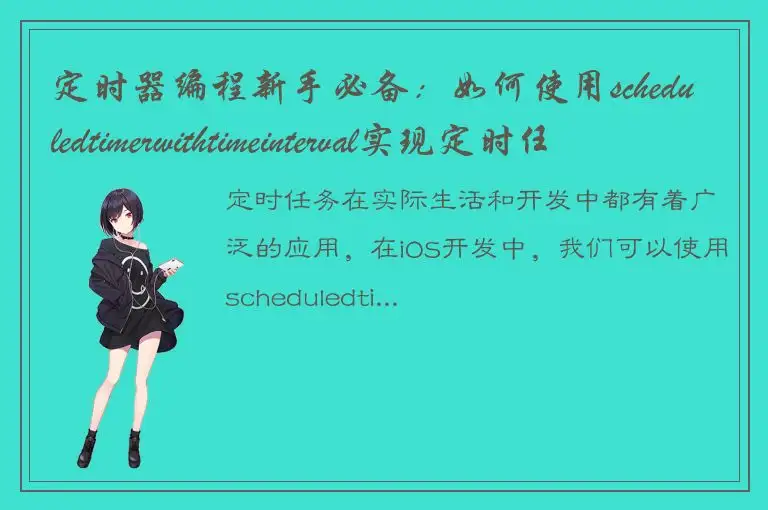定时任务在实际生活和开发中都有着广泛的应用,在iOS开发中,我们可以使用scheduledtimerwithtimeinterval实现定时任务。在本篇文章中,我们将深入探讨如何使用scheduledtimerwithtimeinterval实现定时任务。

1. scheduledTimerWithTimeInterval简介
scheduledTimerWithTimeInterval是iOS开发中用于实现定时任务的常用方法,它可以按照指定的时间间隔重复执行某个方法。scheduledTimerWithTimeInterval接受三个参数,分别是时间间隔、目标对象、需要被执行的方法,调用该方法时,方法会被定时执行。
2. scheduledTimerWithTimeInterval使用
使用scheduledTimerWithTimeInterval方法需要注意以下几点:
2.1 创建定时器
在使用scheduledTimerWithTimeInterval方法创建定时器时,需要保证创建定时器的线程和调用方法的线程是一致的。在ARC中,需要保证使用scheduledTimerWithTimeInterval方法创建的定时器在不需要使用时得到正确的释放。解决方法就是将定时器赋值为一个全局变量或者添加到当前运行循环中,这样可以避免在方法执行之前被释放导致无法执行方法。
2.2 重复执行方法
scheduledTimerWithTimeInterval方法是每隔指定时间执行一次方法,如果想要重复执行某个方法,需要在该方法中再次调用scheduledTimerWithTimeInterval方法。
2.3 定时器暂停
通过invalidate方法可以停止执行定时器,invalidate方法需要在与定时器创建时同样的线程中被调用。
2.4 定时器的准确性
由于scheduledTimerWithTimeInterval使用NSTimeInterval作为时间间隔计算,而NSTimeInterval表示的是以秒为单位的双精度浮点数,因此在计算时间间隔时会存在误差。在精度要求较高的场景中,应使用NSDate对象来计算时间间隔。
3. scheduledTimerWithTimeInterval使用案例
下面我们通过一个案例,了解如何使用scheduledTimerWithTimeInterval实现定时任务。
3.1 创建定时器
首先,我们创建一个单例对象,用于执行打印日志的任务。在单例对象中,创建定时器,并令该定时器每隔1秒执行一次打印日志的方法,代码如下:
```
// 创建定时器并指定时间间隔和需要执行的方法
self.timer = [NSTimer scheduledTimerWithTimeInterval:1.0 target:self selector:@selector(log) userInfo:nil repeats:YES];
```
在定时器的创建过程中,我们需要指定时间间隔、目标对象和需要被执行的方法。在本例中,时间间隔为1秒,目标对象为self,需要被执行的方法为log。
3.2 执行定时任务
在log方法中,我们打印当前时间,并用16进制输出,代码如下:
```
- (void)log{
NSDateFormatter *formatter = [[NSDateFormatter alloc] init];
[formatter setDateFormat:@"yyyy-MM-dd HH:mm:ss:SSS"];
NSDate *date = [NSDate date];
NSString *dateString = [formatter stringFromDate:date];
NSLog(@"当前时间:%@",dateString);
NSLog(@"当前时间戳: %@", [NSString stringWithFormat:@"%lx",(long)[date timeIntervalSince1970]]);
}
```
在打印当前时间前,我们使用NSDateFormatter对象将当前时间转换为字符串类型,方便格式化输出。输出结果为:
```
当前时间:2022-02-28 20:36:00:733
当前时间戳: 622847360000
```
3.3 停止执行定时任务
在执行完定时任务后,我们需要停止执行定时任务,可以在代码中添加如下方法停止执行定时器定时任务:
```
- (void)stopTimer{
if (self.timer) {
[self.timer invalidate];
self.timer = nil;
}
}
```
4. scheduledTimerWithTimeInterval使用小结
本文介绍了scheduledTimerWithTimeInterval的使用,包括创建、执行和停止定时任务,还通过案例详细介绍了如何实现使用scheduledTimerWithTimeInterval实现定时任务的基本流程。在使用scheduledTimerWithTimeInterval时,需要特别注意定时器的准确性和正确释放定时器的方法。理解并掌握scheduledTimerWithTimeInterval的使用,可以为我们在iOS开发中实现定时任务提供便利。




 QQ客服专员
QQ客服专员 电话客服专员
电话客服专员